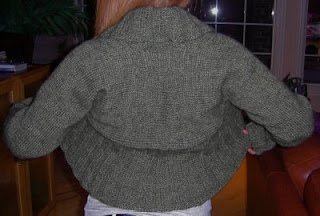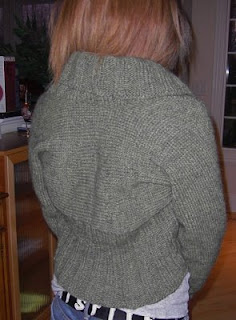Hand knit socks have rapidly become a popular knitting project for many of my students. Trying to teach socks over a three week period was a challenge for me. I have found that there are several obstacles that students face when attempting that first pair.
-Working on double pointed needles (DPNs)
-Working on very small needles (sizes 3 and below)
-Working with fine (thin) yarn in multicolors which often obscure dropped or incorrectly knit stitches.
-Working new techniques.
To help students get a “grasp” on the learning process I wrote the following pattern. I’ve eliminated the smaller needles and difficult yarn. The pattern makes a thicker sock made of worsted weight yarn. If worked two at a time, they can easily be made in the three week time slot. Using the worsted weight wool, it is possible to complete the heel, heel turn, and gusset pickup of stitches in a 2 hour class on one sock.
Download a PDF of Beginner's Socks and Notes on Socks.Beginner’s Socks
Sizes: Child’s, Women’s, Men’s
Finished foot circumference: 6 ½”, 8”, 9”
Abbreviations:
Dpn: double point needle
St: stitch
Sl: slip stitch. Slip all stitches purlwise unless noted.
Ssk: slip1(knitwise), slip1(knitwise), knit the slipped stitches together through the back loop
P2 tog: purl 2 sts together
K2tog: knit 2 sts together
Rnd: round
Stitch Patterns used:
1x1 ribbing—alternate k and p stitches-- knit the knit sts and purl the purl sts.
Stockinette st—knit every round (round knitting) or knit the right side row and purl the wrong side row(flat knitting)
Materials:
Worsted Weight yarn (preferably merino wool) about 350 yds for a 6" sock more or less depending on sock lenght desired. I like Mission Falls 1824 wool which is a superwash, non itching merino wool, perfect for socks.
Set of DPNs (4) sized to knit your yarn at 5 sts per inch.
Darning needle
Gauge: 10 sts= 2" or 5cm. Take time to make a gauge swatch. *see note at end
Cuff and Leg:
Cast onto 1 dpn 32(40:48) stitches. Arrange stitches evenly on 3 dpns. Being careful not to twist stitches, join in the round and work in 1x1 (k1, p1) ribbing for 2 ¾ inches (your tail will mark the beginning and end of each round or you can place a locking marker in the knitting itself). Continue to knit in stockinette st (knit every round) until total length is 5 ½ (7:8) inches or leg length desired.
Heel:
Knit across 8(10:12) sts. Turn work and purl across 16(20:24) sts. These are your heel sts. The other sts will be your instep stitches and will not be knit until later.
Work back and forth (in rows) across the heel sts as follows:
Row 1: Sl 1 (purlwise with yarn in back of work), knit across row
Row 2: Sl 1 (purlwise with yarn in front of work) purl across row
Repeat rows 1 and 2 until 16(20:24) rows have been worked(last row worked should be a purl row)
Turning the heel:
Row 1: Knit across 10(12:14) stitches, ssk, k1, turn work.
Row 2: Sl 1, p5, p2tog, p1, turn.
Row 3: Sl 1, k 6, ssk, k1, turn.
Row 4: Sl1, p 7, p2tog, p1, turn
Row 5: For child’s size: Sl 1, k 8, ssk, turn
For women’s and men’s: Sl 1, k 8, ssk, k1, turn.
Row 6: For child’s size: Sl 1, p8 p2tog. 10 stitches remain. Continue to Gusset instructions.
For women’s and men’s: Sl1, p 9, p2tog, p1, turn.
Row 7: Sl 1, k 10, ssk, (men’s size only k1), turn
Row 8: Women’s size: Sl1, p 10, p2tog. 12 stitches remain. Continue to Gusset instructions
Men’s size: Sl 1, p11, p2 tog, p1 turn
Row 9: Sl 1, k 12, ssk, turn.
Row10: Sl 1, p13, p2tog. 14 stitches remain. Continue to Gusset instructions.
Gusset:
You will now begin knitting in the round again as follows:
Knit across all heel sts and with the same dpn pick up and knit 8(10:12) sts along the selvedge edge of the heel flap. This is needle # 1
With another dpn, work across the 16 (20:24) instep stitches. This is needle #2.
With another dpn, pick up and knit 8(10:12) stitches along the other selvedge of the heel flap the knit across 4(5:6) sts on needle #1(half of the heel stitches). This is needle #3.
The round now begins between needle# 3 and needle # 1—the middle of the heel.
Rnd 1: Needle #1-- Knit to last three stitches, k2 tog, k1. Needle #2: Knit across all stitches. Needle #3: K1, ssk, knit to end.
Rnd 2: Knit without any decreases.
Repeat Rnds 1 and 2 until 32(40:48) stitches remain.
Foot:
Work even in stockinette stitch until measure 5 ½(7:8 ½) inches from back of
heel or about 1 ¾ (2 ¼:2 ½) inches less than desired foot length.
Toe:
Rnd 1: Needle #1: Knit to last three sts, k2tog,k1. Needle #2: K1,ssk, knit to
last three sts, k2tog, k1. Needle #3: K1, ssk, knit to end.
Rnd 2: Knit without any decreases.
Repeat rnds 1 and 2 until 16 (20:24) sts remain.
Then repeat only rnd 1 until 12 (16:16) sts remain.
Knit stitches from needle #1 onto needle #3.
Cut yarn leaving an 18 inch tail. Graft together the stitches from needles 2 and 3
using the Kitchenerʼs stitch.
Weave in all ends and block if desired.
 Notes about Knitting Socks
Notes about Knitting Socks
Materials:
Yarn: Wool or wool blends are recommended simply because wool breathes and wicks moisture. It is also naturally elastic. Many sock wools are made to be “non-itchy” and are machine washable , check the yarn label for washing instructions. Cotton also breathes and wicks moisture but it lacks elasticity. Cotton does better when knit along side a small piece of elastic. Acrylic is not recommended as it does not breathe or wick moisture.
Elastic: Some knitters use elastic throughout the sock for extra elasticity others use elastic in the cuff, heel and toe as reinforcement. When knitting with wool, elastic is usually not necessary. This is the knitter’s choice.
Socks are knit in steps:
Cuff and leg
Heel
Turn of heel
Gusset
Foot
Toe
Grafting of toe
Kitchner’s Grafting Stitch:
This stitch joins two “live” edges together without creating a bulky seam—ideal for toes!
Thread tail through darning needle.
Caveats:
--All stitches must be worked 2 times before removing them from the needle.
--Except for preliminary stitches and final stitches, work the first 2 stitches on the front needle then the first two stitches on the back needle.
Preliminary stitches: Holding the two knitting needles parallel with the yarn attached to the back needle, thread the yarn purlwise through the first stitch on the first needle then thread the yarn knitwise through the first stitch on the back needle.
On the front needle thread the darning needle through the first stitch knitwise, then the second stitch purlwise. Remove the first stitch.
Now on the back needle thread the darning needle purlwise through the first stitch and knitwise through the second stitch. Remove the first stitch. Tighten.
Remember: Knit/ purl (front needle)
Purl /knit (back needle)
Repeat until only 1 stitch remains on each needle and finish final stitches:
Thread darning needle knitwise on front needle and purlwise on back needle. Remove both stitches, tighten and pull tail through to wrong side.
Ideal class schedule:
Class 1: cast on join in round.. At home: knit cuff and leg
Class 2: heel, heel turn, set up gusset. At home: knit gusset and foot
Class 3: toe and grafting.
A note on gauge swatches. This is how I have first timers make a sock gauge swatch:
Cast on enough stitchs for 2 inches according to the gauge in the pattern.
Knitting in
rows work several inches and measure. Adjust needle sizes until swatch measures 2" across.
This method while technically incorrect is less intimidating to students and has proved to be accurate enough to knit a pair of socks that fit the recipient. After they've mastered the sock process I will then introduce them to swatching in the round.


















